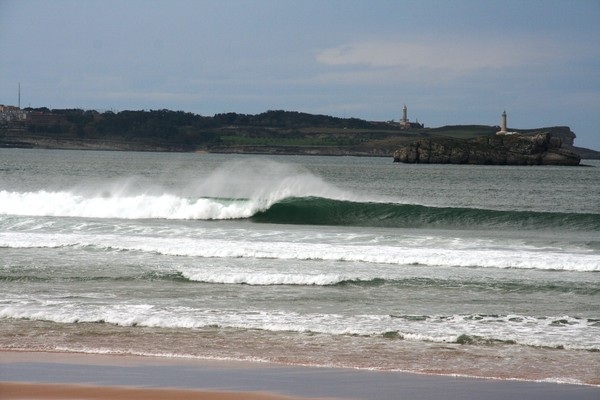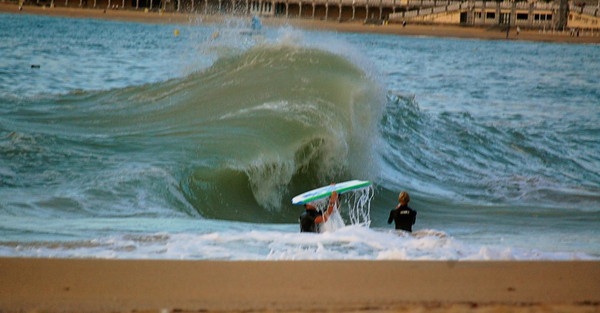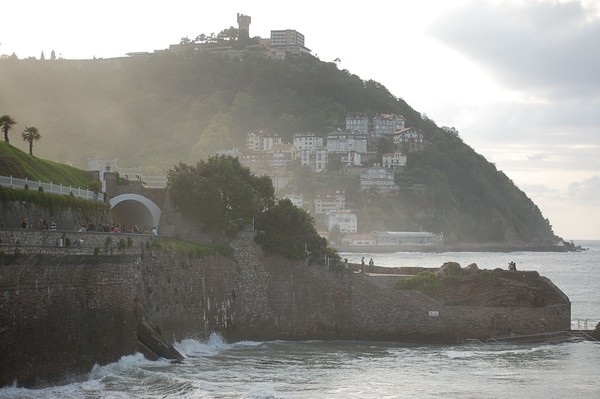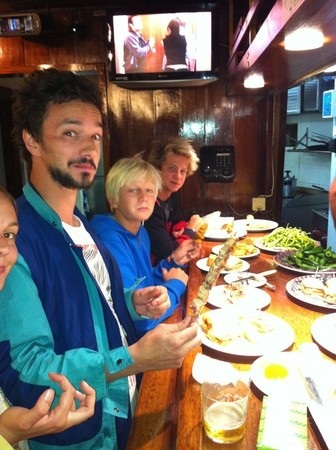This is a great series, lots of interesting information and photos. Definitely makes me want to travel!
VIA – ENCINITAS PATCH

Tubes and Tapas: Surfing Spain’s North Coast
The second part of a three-part series on surfing and travel in Europe in the fall.
The tapa or pintxo, with its gelatinous and vegetable covering, looked delicious.
Since the bartenders in this historic district Santander bar are typically rude, if not downright hostile, I didn’t bother asking what the ingredients were.
But the first taste caused me to gag and push away my plate.
“You know that gelatin is made from pig’s feet,” said Robert Amasuno, our guide and a longtime local surfer.
The last time I was in Santander, on Spain’s stunning northern coast in Cantabria was in the fall of 1983 when I spent a few days surfing on a trip with my little brother Nick and my mother. We took the ferry from Plymouth to Santander on our way to Meknes, Morocco, where my dad was working on a United Nations project. I spent my senior year of high school in Madrid and after our trip to Morocco I spent a semester at Madrid’s Complutense University.
Back then, the coast around Santander provided endless empty beachbreak waves, warm water and just a few local surfers. The food was excellent. I’ll never forget a dinner of braised rabbit at a rustic country restaurant.
Today northern Spain is a different world. Endless rows of abandoned vacation condos litter the coast. Seeing the numerous abandoned construction cranes and vacation villages in Spain is a great way to understand the European and Spanish financial crisis. Surfing is now a big deal with skilled and experienced surfers populating beach cities.

But northern Spain still has a rustic charm that is hard to ignore. The massive Cantabrian range provides a rugged backdrop to the green coast. Hikers enjoy the wildlife and scenery of the rocky shoreline. Picturesque cafes and restaurants serve up mouthwatering seafood.
On this most recent trip I was with Ben McCue and Zach Plopper of WiLDCOAST who had spent a year studying in Santander. We attended the inaugural Global Wave Conference Oct. 24-25 in Biarritz and San Sebastian, and were anxious to sample the world-class Spanish surf.
The second day of the conference took place in San Sebastian at the ultra modernist Kursaal Conference Center designed by Rafael Moneo at the east end of La Zurriola beach. I previously visited San Sebastian in July during a trip with my two sons and French cousins.
When we arrived the surf was firing. We could see a small crowd ride double overhead offshore waves at the west end of the beach. Bigger bombs to the east went unridden.
The minute the conference ended, participants grabbed boards, stuffed themselves into wetsuits and paddled out for the evening surf. The surf was well overhead and still offshore.
Soon the lineup was populated with surfer-conservationists from South Africa, Spain, France, England, Japan, Portugal, Australia and the U.S. who shared the plentiful peaks and hooted the best rides.
After our surf, we assembled at the seaside People Café and Lounge on the malecon overlooking La Zurriola to sample pinxtos, jamon serrano, San Miguel beer and Rioja wine.
It was a great ending to an inspiring conference.
The following day we headed out to Mundaka. Unfortunately the swell dropped and everyone from northern Spain seemed to have descended on this gorgeous Basque village.
We paddled out through the ancient port, caught a couple of waves and then paddled back in.
At a bar overlooking the epic lefthander, considered to be one of the best waves in the world, we ate bocatas de tortilla de patata and admired the framed photo of the world’s best surfers who had surfed here when Mundaka was an important stop on the ASP Dream Tour.
When storms move in from the north Atlantic, the wind on the north coast of Spain can turn offshore for days. With south winds still howling and providing offshore conditions, we decided to drive west toward Santander.
“We’ll hit up this cool beach we love to surf,” Ben said. “It should be firing.”
About an hour later, we found ourselves winding through a river valley and driving alongside an empty wild beach. In the distance we spotted offshore peaks.
Soon after we were surfing 3-4’ uncrowded A-frames. After our surf we found a nearby café and dug into bowls of pulpo and and calamar.
That evening we found Robert in Santander. Over pinchos and cañas de cerveza he promised a great session at another beach the following morning. “It will be pumping,” he promised.

The following morning I found myself overlooking deep aqua colored offshore peaks from the cliffs of Dunas de Liencres Natural Park. Pine covered dunes and sandstone cliffs protect the sandy shoreline and a large estuary.
The lineup was empty and there were sandbar peaks up and down the beach.
Out in the water, we all rode hollow overhead waves. A couple of Spanish surfers paddled out, but there were plenty of waves for everyone.
“Most of the time in the winter I surf here by myself,” Robert said.

Back in the parking lot after our session, the wind was still offshore and the tide had dropped, shifting the swell down the beach to an insane right peeling off an inside sandbar.
A week later after I got home, I received an email from Zach who eventually flew to Bilbao via Paris with Ben.
“Yesterday we scored Rodiles [a left point] – Mundaka’s little, yet hotter, sister,” his email said. “We have been blessed with two weeks of offshore south wind and swell.”
If you decide to travel coastal Spain, your best bet is to rent a car, explore the coast and lodge at small hotels or pensiones in the coastal villages.
While Spanish surfers aren’t that friendly, the same advice applies…
For the full article go here:
http://encinitas.patch.com/articles/tubes-and-tapas-surfing-the-north-coast-of-spain#photo-7153810
 Become A Sponsor!
Become A Sponsor!If you have a product or service that is a good fit for our surf community, we have opportunities for you to sponsor this blog! Download our media kit now!
